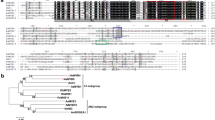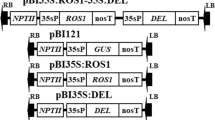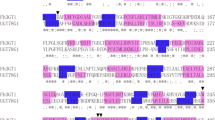Abstract
Key message
Ectopic expression of PhAN2 in vegetative tissue can improve regeneration and adventitious rooting but inhibit axillary bud outgrowth of petunia, while overexpression specifically in flowers could shorten longevity.
Abstract
Anthocyanin 2 has been only treated as a critical positive regulation factor of anthocyanin biosynthesis in petunia flowers. To determine if this gene had other functions in plant growth, we overexpressed this gene in an an2 mutant petunia cultivar driven by promoters with different strengths or tissue specificity. Various physiological processes of transformants in different growth stages and environments were analyzed. Besides the expected pigmentation improvement in different tissues, the results also showed that ectopic expression of AN2 could improve the regeneration skill but inhibit the axillary bud germination of in vitro plants. Moreover, the rooting ability of shoot tips of transformants was significantly improved, while some transgenic lines’ flower longevity was shortened. Gene expression analysis showed that the transcripts level of AN2, partner genes anthocyanin 1 (AN1), anthocyanin 11 (AN11), and target gene dihydroflavonol 4-reductase (DFR) was altered in the different transgenic lines. In addition, ethylene biosynthesis-related genes 1-aminocyclopropane-1-carboxylic acid synthase (ACS1) and ACC oxidase (ACO1) were upregulated in rooting and flower senescence processes but at different time points. Overall, our data demonstrate that the critical role of this AN2 gene in plant growth physiology may extend beyond that of a single activator of anthocyanin biosynthesis.








Similar content being viewed by others
Data availability
All data generated in this study are available in the article and its supplementary information.
References
Ai TN, Naing AH, Arun M et al (2017) Expression of RsMYB1 in Petunia enhances anthocyanin production in vegetative and floral tissues. Sci Hortic 214:58–65. https://doi.org/10.1016/j.scienta.2016.11.016
Alaey M, Babalar M, Naderi R et al (2011) Effect of pre-and postharvest salicylic acid treatment on physio-chemical attributes in relation to vase-life of rose cut flowers. Postharvest Biol Technol 61(1):91–94. https://doi.org/10.1016/j.postharvbio.2011.02.002
Albert NW, Lewis DH, Zhang H et al (2009) Light-induced vegetative anthocyanin pigmentation in Petunia. J Exp Bot 60:2191–2202. https://doi.org/10.1093/jxb/erp097
Albert NW, Lewis DH, Zhang H et al (2011) Members of an R2R3-MYB transcription factor family in Petunia are developmentally and environmentally regulated to control complex floral and vegetative pigmentation patterning. Plant J 65:771–784. https://doi.org/10.1111/j.1365-313X.2010.04465.x
Albert NW, Davies KM, Lewis DH et al (2014) A conserved network of transcriptional activators and repressors regulates anthocyanin pigmentation in eudicots. Plant Cell 26:962–980. https://doi.org/10.1105/tpc.113.122069
An JP, Wang XF, Li YY et al (2018) EIN3-LIKE1, MYB1, and ETHYLENE RESPONSE FACTOR3 act in a regulatory loop that synergistically modulates ethylene biosynthesis and anthocyanin accumulation. Plant Physiol 178:808–823. https://doi.org/10.1104/pp.18.00068
Angenent GC, Busscher M, Franken J et al (1992) Differential expression of two MADS box genes in wild-type and mutant petunia flowers. Plant Cell 4:983–993. https://doi.org/10.1105/tpc.4.8.983
Ausubel FM, Bahnsen K, Hanson M (1980) Cell and tissue culture of haploid and diploid Petunia ‘Mitchell.’ Plant Mol Biol Newsl 1:26–32
Bombarely A, Moser M, Amrad A et al (2016) Insight into the evolution of the Solanaceae from the parental genomes of Petunia hybrida. Nat Plants 2:1–9. https://doi.org/10.1038/nplants.2016.74
Cavallini E, Zenoni S, Finezzo L et al (2014) Functional diversification of grapevine MYB5a and MYB5b in the control of flavonoid biosynthesis in a petunia anthocyanin regulatory mutant. Plant Cell Physiol 55:517–534. https://doi.org/10.1093/pcp/pct190
Chatfield SP, Stirnberg P, Forde BG et al (2000) The hormonal regulation of axillary bud growth in Arabidopsis. Plant J 24:159–169. https://doi.org/10.1046/j.1365-313X.2000.00862.x
Clark DG, Dervinis C, Barrett JE et al (2004) Drought-induced leaf senescence and horticultural performance of transgenic PSAG12-ipt petunias. J Am Soc Hortic Sci 129:93–99. https://doi.org/10.21273/JASHS.129.1.0093
De Vlaming P (1981) Genotype determination of Petunia ‘Mitchell’with respect to some flower colour genes. Plant Mol Biol News II:106–108
De Vetten N, Quattrocchio F, Mol J et al (1997) The an11 locus controlling flower pigmentation in petunia encodes a novel WD-repeat protein conserved in yeast, plants, and animals. Genes Dev 11:1422–1434. https://doi.org/10.1101/gad.11.11.1422
Dimasi-Theriou K, Economou AS, Sfakiotakis EM (1993) Promotion of petunia (Petunia hybrida L.) regeneration in vitro by ethylene. Plant Cell Tissue Organ Cult 32:219–225. https://doi.org/10.1007/BF00029846
Dorokhov DB, Klocke E (1997) A rapid and economic technique for RAPD analysis of plant genomes. Genetika 33:443–450
Druege U, Franken P, Lischewski S et al (2014) Transcriptomic analysis reveals ethylene as stimulator and auxin as regulator of adventitious root formation in petunia cuttings. Front Plant Sci 5:1–19. https://doi.org/10.3389/fpls.2014.00494
Edwards K, Johnstone C, Thompson C (1991) A simple and rapid method for the preparation of plant genomic DNA for PCR analysis. Nucleic Acids Re 19(6):1349. https://doi.org/10.1093/nar/19.6.1349
Esfeld K, Berardi AE, Moser M et al (2018) Pseudogenization and resurrection of a speciation gene. Curr Biol 28:3776–3786. https://doi.org/10.1016/j.cub.2018.10.019
Espley RV, Leif D, Plunkett B et al (2019) Red to brown: an elevated anthocyanic response in apple drives ethylene to advance maturity and fruit flesh browning. Front Plant Sci 10:1–15. https://doi.org/10.3389/fpls.2019.01248
Fatihah HNN, Moñino D, Arkel GV et al (2019) The ROSEA1 and DELILA transcription factors control anthocyanin biosynthesis in Nicotiana benthamiana and Lilium flowers. Sci Hortic 243:327–337. https://doi.org/10.1016/j.scienta.2018.08.042
Gapper NE, McKenzie MJ, Christey MC et al (2002) Agrobacterium tumefaciens-mediated transformation to alter ethylene and cytokinin biosynthesis in broccoli. Plant Cell Tissue Organ Cult 70:41–50. https://doi.org/10.1023/A:1016057208267
Gebhardt C (2016) The historical role of species from the Solanaceae plant family in genetic research. Theor Appl Genet 129:2281–2294. https://doi.org/10.1007/s00122-016-2804-1
Gehl C, Wamhoff D, Schaarschmidt F et al (2018) Improved leaf and flower longevity by expressing the etr1-1 allele in Pelargonium zonale under control of FBP1 and SAG12 promoters. Plant Growth Regul 86:351–363. https://doi.org/10.1007/s10725-018-0434-0
Haver D, Schuch U (2001) Influence of root restriction and ethylene exposure on apical dominance of petunia (Petunia x hybrida Hort. Vilm.-Andr.). Plant Growth Regul 35:187–196. https://doi.org/10.1023/A:1014491400397
Haver DL, Schuch UK, Lovatt CJ (2002) Exposure of petunia seedlings to ethylene decreased apical dominance by reducing the ratio of auxin to cytokinin. J Plant Growth Regul 21:459–468. https://doi.org/10.1007/s00344-002-0022-3
Hoballah ME, Gübitz T, Stuurman J et al (2007) Single gene-mediated shift in pollinator attraction in Petunia. Plant Cell 19:779–790. https://doi.org/10.1105/tpc.106.048694
Holton TA, Brugliera F, Tanaka Y (1993) Cloning and expression of flavonol synthase from Petunia hybrida. Plant J 4:1003–1010. https://doi.org/10.1046/j.1365-313X.1993.04061003.x
Huang LC, Lai UL, Yang SF et al (2007) Delayed flower senescence of Petunia hybrida plants transformed with antisense broccoli ACC synthase and ACC oxidase genes. Postharvest Biol Technol 46:47–53. https://doi.org/10.1016/j.postharvbio.2007.03.015
Ikeuchi M, Shibata M, Rymen B et al (2018) A gene regulatory network for cellular reprogramming in plant regeneration. Plant Cell Physiol 59:765–777. https://doi.org/10.1093/pcp/pcy013
Jian W, Cao HH, Yuan S et al (2019) SlMYB75, an MYB-type transcription factor, promotes anthocyanin accumulation and enhances volatile aroma production in tomato fruits. Hortic Res 6:22. https://doi.org/10.1038/s41438-018-0098-y
Khan N (2006) Ethylene action in plants. Springer Berlin Heidelberg
Koes R, Verweij W, Quattrocchio F (2005) Flavonoids: A colorful model for the regulation and evolution of biochemical pathways. Trends Plant Sci 10:236–242. https://doi.org/10.1016/j.tplants.2005.03.002
Li S, Wang W, Gao J et al (2016) MYB75 phosphorylation by MPK4 is required for light-induced anthocyanin accumulation in Arabidopsis. Plant Cell 28:2866–2883. https://doi.org/10.1105/tpc.16.00130
Lin Y, Jones ML (2021) Silencing ATG6 and PI3K accelerates petal senescence and reduces flower number and shoot biomass in petunia. Plant Sci 302:110713
Mallona I, Lischewski S, Weiss J et al (2010) Validation of reference genes for quantitative real-time PCR during leaf and flower development in Petunia hybrida. BMC Plant Biol 10:1–11. https://doi.org/10.1186/1471-2229-10-4
Meng X, Yang D, Li X et al (2015) Physiological changes in fruit ripening caused by overexpression of tomato SlAN2, an R2R3-MYB factor. Plant Physiol Biochem 89:24–30. https://doi.org/10.1016/j.plaphy.2015.02.005
Meng J, Gao Y, Han M et al (2020) In vitro anthocyanin induction and metabolite analysis in Malus spectabilis leaves under low nitrogen conditions. Hortic Plant J 6:284–292. https://doi.org/10.1016/j.hpj.2020.06.004
Meyer P, Heidmann I, Forkmannr G (1987) A new petunia flower colour generated by transformation of a mutant with a maize gene. Nature 330:677–678. https://doi.org/10.1038/330677a0
Murashige T, Skoog F (1962) A revised medium for rapid growth and bioassays with tobacco. Phy 15:473–497. https://doi.org/10.1111/j.1399-3054.1962.tb08052.x
Muszyński S (1968) A survey of anthocyanins in Petunia. Acta Soc Bot Pol 37:427–432
Napoli C, Lemieux C, Jorgensen R (1990) Introduction of a chimeric chalcone synthase gene into petunia results in reversible co-suppression of homologous genes in trans. Plant Cell 2:279–289. https://doi.org/10.2307/3869076
Povero G (2011) Physiological and genetic control of anthocyanin pigmentation in different species. Dissertation, Vrije Universiteit of Amsterdam.
Quattrocchio F, Wing JF, Leppen HTC et al (1993) Regulatory genes controlling anthocyanin pigmentation are functionally conserved among plant species and have distinct sets of target genes. Plant Cell 5:1497–1512. https://doi.org/10.2307/3869734
Quattrocchio F, Wing JF, Van der Woude K et al (1998) Analysis of bHLH and MYB domain proteins: Species-specific regulatory differences are caused by divergent evolution of target anthocyanin genes. Plant J 13:475–488. https://doi.org/10.1046/j.1365-313X.1998.00046.x
Quattrocchio F, Wing J, Van Der Woude K et al (1999) Molecular analysis of the anthocyanin2 gene of Petunia and its role in the evolution of flower color. Plant Cell 11:1433–1444. https://doi.org/10.1105/tpc.11.8.1433
Quattrocchio F, Verweij W, Kroon A et al (2006) PH4 of petunia is an R2R3 MYB protein that activates vacuolar acidification through interactions with basic-helix-loop-helix transcription factors of the anthocyanin pathway. Plant Cell 18:1274–1291. https://doi.org/10.1105/tpc.105.034041
Rahim MA, Resentini F, Dalla Vecchia F et al (2019) Effects on plant growth and reproduction of a peach R2R3-MYB transcription factor overexpressed in tobacco. Front Plant Sci 10:1143
Sanikhani M, Mibus H, Stummann BM et al (2008) Kalanchoe blossfeldiana plants expressing the Arabidopsis etr1-1 allele show reduced ethylene sensitivity. Plant Cell Rep 27:729–737. https://doi.org/10.1007/s00299-007-0493-6
Schwinn K, Venail J, Shang Y et al (2006) A small family of MYB-regulatory genes controls floral pigmentation intensity and patterning in the genus Antirrhinum. Plant Cell 18:831–851. https://doi.org/10.1105/tpc.105.039255
Schwinn K, Miosic S, Davies K et al (2014) The B-ring hydroxylation pattern of anthocyanins can be determined through activity of the flavonoid 3′-hydroxylase on leucoanthocyanidins. Planta 240:1003–1010. https://doi.org/10.1007/s00425-014-2166-3
Serek M, Woltering EJ, Sisler EC et al (2006) Controlling ethylene responses in flowers at the receptor level. Biotechnol Adv 24:368–381. https://doi.org/10.1016/j.biotechadv.2006.01.007
Sgamma T, Thomas B, Muleo R (2015) Ethylene inhibitor silver nitrate enhances regeneration and genetic transformation of Prunus avium (L.) cv Stella. Plant Cell Tissue Organ Cult 120:79–88. https://doi.org/10.1007/s11240-014-0581-6
Shibuya K, Barry KG, Ciardi JA et al (2004) The central role of PhEIN2 in ethylene responses throughout plant development in petunia1. Plant Physiol 136:2900–2912. https://doi.org/10.1104/pp.104.046979
Shvarts M, Borochov A, Weiss D (1997) Low temperature enhances petunia flower pigmentation and induced chalcone synthase gene expression. Physiol Plant 99:67–72. https://doi.org/10.1034/j.1399-3054.1997.990110.x
Sijacic P, Wang X, Skirpan AL et al (2004) Identification of the pollen determinant of S-RNase-mediated self-incompatibility. Nature 429:302–305. https://doi.org/10.1038/nature02523
Sriskandarajah S, Mibus H, Serek M (2007) Transgenic Campanula carpatica plants with reduced ethylene sensitivity. Plant Cell Rep 26:805–813. https://doi.org/10.1007/s00299-006-0291-6
Spelt C, Quattrocchio F, Mol JNM et al (2000) Anthocyanin1 of Petunia encodes a basic helix-loop-helix protein that directly activates transcription of structural anthocyanin genes. Plant Cell 12:1619–1631. https://doi.org/10.1105/tpc.12.9.1619
Takos AM, Jaffé FW, Jacob SR et al (2006) Light-induced expression of a MYB gene regulates anthocyanin biosynthesis in red apples. Plant Physiol 142:1216–1232. https://doi.org/10.1104/pp.106.088104
Van Der Krol AR, Mur LA, Beld M et al (1990) Flavonoid genes in petunia: addition of a limited number of gene copies may lead to a suppression of gene expression. Plant Cell 2:291–299. https://doi.org/10.1105/tpc.2.4.291
Whale SK, Singh Z (2007) Endogenous ethylene and color development in the skin of “Pink Lady” apple. J Am Soc Hortic Sci 132:20–28. https://doi.org/10.21273/jashs.132.1.20
Winkelmann T, Warwas M, Raffeiner B et al (2016) Improved postharvest quality of inflorescences of fbp1: etr1-1 transgenic Burrageara ‘Stefan Isler Lava Flow.’ J Plant Growth Regul 35:390–400. https://doi.org/10.1007/s00344-015-9545-2
Xu J, Kang BC, Naing AH et al (2020) CRISPR/Cas9-mediated editing of 1-aminocyclopropane-1-carboxylate oxidase1 enhances Petunia flower longevity. Plant Biotechnol J 18:287–297. https://doi.org/10.1111/pbi.13197
Xu J, Naing AH, Bunch H et al (2021) Enhancement of the flower longevity of petunia by CRISPR/Cas9-mediated targeted editing of ethylene biosynthesis genes. Postharvest Biol Technol 174:111460. https://doi.org/10.1016/j.postharvbio.2020.111460
Zahn LM, Leebens-Mack J, De Pamphilis CW et al (2005) To B or not to B a flower: the role of DEFICIENS and GLOBOSA orthologs in the evolution of the angiosperms. J Hered 96:225–240. https://doi.org/10.1093/jhered/esi033
Zhang J, Xu H, Wang N et al (2018) The ethylene response factor MdERF1B regulates anthocyanin and proanthocyanidin biosynthesis in apple. Plant Mol Biol 98:205–218. https://doi.org/10.1007/s11103-018-0770-5
Zhang B, Xu X, Huang R, Yang S et al (2021) CRISPR/Cas9-mediated targeted mutation reveals a role for AN4 rather than DPL in regulating venation formation in the corolla tube of Petunia hybrida. Hortic Res. https://doi.org/10.1038/s41438-021-00555-6
Acknowledgements
The authors would like to thank Dietz Felix Michaelis, the laboratory staff, and the gardeners of the Section Floriculture at the Leibniz University Hannover for technical assistance. Guo Li gratefully acknowledges financial support from the China Scholarship Council (CSC) scholarship.
Funding
No external funding was used.
Author information
Authors and Affiliations
Contributions
CG and GL conceived and designed the research. GL conducted the experiments and analyzed the data. GL and CG wrote and revised the manuscript. MS revised the manuscript and supervised the project. All authors read and approved the final manuscript.
Corresponding author
Ethics declarations
Conflict of interest
The authors declare that they have no conflict of interest.
Additional information
Communicated by Ralf Welsch.
Publisher's Note
Springer Nature remains neutral with regard to jurisdictional claims in published maps and institutional affiliations.
Supplementary Information
Below is the link to the electronic supplementary material.
Rights and permissions
Springer Nature or its licensor (e.g. a society or other partner) holds exclusive rights to this article under a publishing agreement with the author(s) or other rightsholder(s); author self-archiving of the accepted manuscript version of this article is solely governed by the terms of such publishing agreement and applicable law.
About this article
Cite this article
Li, G., Serek, M. & Gehl, C. Physiological changes besides the enhancement of pigmentation in Petunia hybrida caused by overexpression of PhAN2, an R2R3-MYB transcription factor. Plant Cell Rep 42, 609–627 (2023). https://doi.org/10.1007/s00299-023-02983-1
Received:
Accepted:
Published:
Issue Date:
DOI: https://doi.org/10.1007/s00299-023-02983-1




